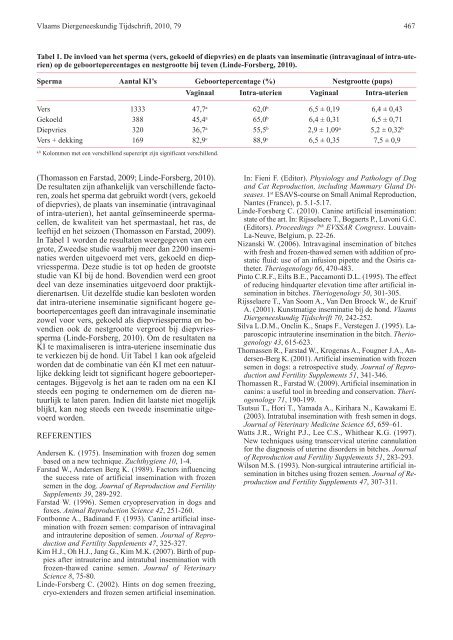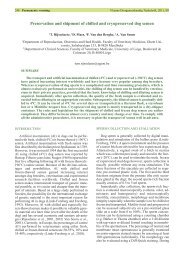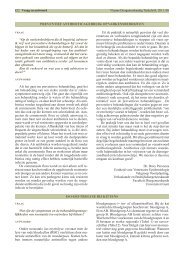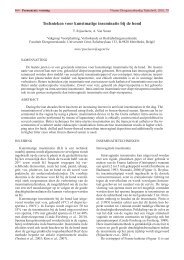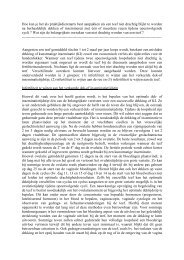Technieken voor kunstmatige inseminatie bij de hond - Kliniek ...
Technieken voor kunstmatige inseminatie bij de hond - Kliniek ...
Technieken voor kunstmatige inseminatie bij de hond - Kliniek ...
Create successful ePaper yourself
Turn your PDF publications into a flip-book with our unique Google optimized e-Paper software.
Vlaams Diergeneeskundig Tijdschrift, 2010, 79 467<br />
Tabel 1. De invloed van het sperma (vers, gekoeld of diepvries) en <strong>de</strong> plaats van <strong>inseminatie</strong> (intravaginaal of intra-uterien)<br />
op <strong>de</strong> geboortepercentages en nestgrootte <strong>bij</strong> teven (Lin<strong>de</strong>-Forsberg, 2010).<br />
Sperma Aantal KI’s Geboortepercentage (%) Nestgrootte (pups)<br />
Vaginaal Intra-uterien Vaginaal Intra-uterien<br />
Vers 1333 47,7 a 62,0 b 6,5 ± 0,19 6,4 ± 0,43<br />
Gekoeld 388 45,4 a 65,0 b 6,4 ± 0,31 6,5 ± 0,71<br />
Diepvries 320 36,7 a 55,5 b 2,9 ± 1,09 a 5,2 ± 0,32 b<br />
Vers + <strong>de</strong>kking 169 82,9 c 88,9 c 6,5 ± 0,35 7,5 ± 0,9<br />
a,b Kolommen met een verschillend supercript zijn significant verschillend.<br />
(Thomasson en Farstad, 2009; Lin<strong>de</strong>-Forsberg, 2010).<br />
De resultaten zijn afhankelijk van verschillen<strong>de</strong> factoren,<br />
zoals het sperma dat gebruikt wordt (vers, gekoeld<br />
of diepvries), <strong>de</strong> plaats van <strong>inseminatie</strong> (intravaginaal<br />
of intra-uterien), het aantal geïnsemineer<strong>de</strong> spermacellen,<br />
<strong>de</strong> kwaliteit van het spermastaal, het ras, <strong>de</strong><br />
leeftijd en het seizoen (Thomasson en Farstad, 2009).<br />
In Tabel 1 wor<strong>de</strong>n <strong>de</strong> resultaten weergegeven van een<br />
grote, Zweedse studie waar<strong>bij</strong> meer dan 2200 <strong>inseminatie</strong>s<br />
wer<strong>de</strong>n uitgevoerd met vers, gekoeld en diepvriessperma.<br />
Deze studie is tot op he<strong>de</strong>n <strong>de</strong> grootste<br />
studie van KI <strong>bij</strong> <strong>de</strong> <strong>hond</strong>. Bovendien werd een groot<br />
<strong>de</strong>el van <strong>de</strong>ze <strong>inseminatie</strong>s uitgevoerd door praktijkdierenartsen.<br />
Uit <strong>de</strong>zelf<strong>de</strong> studie kan besloten wor<strong>de</strong>n<br />
dat intra-uteriene <strong>inseminatie</strong> significant hogere geboortepercentages<br />
geeft dan intravaginale <strong>inseminatie</strong><br />
zowel <strong>voor</strong> vers, gekoeld als diepvriessperma en bovendien<br />
ook <strong>de</strong> nestgrootte vergroot <strong>bij</strong> diepvriessperma<br />
(Lin<strong>de</strong>-Forsberg, 2010). Om <strong>de</strong> resultaten na<br />
KI te maximaliseren is intra-uteriene <strong>inseminatie</strong> dus<br />
te verkiezen <strong>bij</strong> <strong>de</strong> <strong>hond</strong>. Uit Tabel 1 kan ook afgeleid<br />
wor<strong>de</strong>n dat <strong>de</strong> combinatie van één KI met een natuurlijke<br />
<strong>de</strong>kking leidt tot significant hogere geboortepercentages.<br />
Bijgevolg is het aan te ra<strong>de</strong>n om na een KI<br />
steeds een poging te on<strong>de</strong>rnemen om <strong>de</strong> dieren natuurlijk<br />
te laten paren. Indien dit laatste niet mogelijk<br />
blijkt, kan nog steeds een twee<strong>de</strong> <strong>inseminatie</strong> uitgevoerd<br />
wor<strong>de</strong>n.<br />
REFERENTIES<br />
An<strong>de</strong>rsen K. (1975). Insemination with frozen dog semen<br />
based on a new technique. Zuchthygiene 10, 1-4.<br />
Farstad W., An<strong>de</strong>rsen Berg K. (1989). Factors influencing<br />
the success rate of artificial insemination with frozen<br />
semen in the dog. Journal of Reproduction and Fertility<br />
Supplements 39, 289-292.<br />
Farstad W. (1996). Semen cryopreservation in dogs and<br />
foxes. Animal Reproduction Science 42, 251-260.<br />
Fontbonne A., Badinand F. (1993). Canine artificial insemination<br />
with frozen semen: comparison of intravaginal<br />
and intrauterine <strong>de</strong>position of semen. Journal of Reproduction<br />
and Fertility Supplements 47, 325-327.<br />
Kim H.J., Oh H.J., Jang G., Kim M.K. (2007). Birth of puppies<br />
after intrauterine and intratubal insemination with<br />
frozen-thawed canine semen. Journal of Veterinary<br />
Science 8, 75-80.<br />
Lin<strong>de</strong>-Forsberg C. (2002). Hints on dog semen freezing,<br />
cryo-exten<strong>de</strong>rs and frozen semen artificial insemination.<br />
In: Fieni F. (Editor). Physiology and Pathology of Dog<br />
and Cat Reproduction, including Mammary Gland Diseases.<br />
1 st ESAVS-course on Small Animal Reproduction,<br />
Nantes (France), p. 5.1-5.17.<br />
Lin<strong>de</strong>-Forsberg C. (2010). Canine artificial insemination:<br />
state of the art. In: Rijsselaere T., Bogaerts P., Luvoni G.C.<br />
(Editors). Proceedings 7 th EVSSAR Congress. Louvain-<br />
La-Neuve, Belgium, p. 22-26.<br />
Nizanski W. (2006). Intravaginal insemination of bitches<br />
with fresh and frozen-thawed semen with addition of prostatic<br />
fluid: use of an infusion pipette and the Osiris catheter.<br />
Theriogenology 66, 470-483.<br />
Pinto C.R.F., Eilts B.E., Paccamonti D.L. (1995). The effect<br />
of reducing hindquarter elevation time after artificial insemination<br />
in bitches. Theriogenology 50, 301-305.<br />
Rijsselaere T., Van Soom A., Van Den Broeck W., <strong>de</strong> Kruif<br />
A. (2001). Kunstmatige <strong>inseminatie</strong> <strong>bij</strong> <strong>de</strong> <strong>hond</strong>. Vlaams<br />
Diergeneeskundig Tijdschrift 70, 242-252.<br />
Silva L.D.M., Onclin K., Snaps F., Verstegen J. (1995). Laparoscopic<br />
intrauterine insemination in the bitch. Theriogenology<br />
43, 615-623.<br />
Thomassen R., Farstad W., Krogenas A., Fougner J.A., An<strong>de</strong>rsen-Berg<br />
K. (2001). Artificial insemination with frozen<br />
semen in dogs: a retrospective study. Journal of Reproduction<br />
and Fertility Supplements 51, 341-346.<br />
Thomassen R., Farstad W. (2009). Artificial insemination in<br />
canins: a useful tool in breeding and conservation. Theriogenology<br />
71, 190-199.<br />
Tsutsui T., Hori T., Yamada A., Kirihara N., Kawakami E.<br />
(2003). Intratubal insemination with fresh semen in dogs.<br />
Journal of Veterinary Medicine Science 65, 659–61.<br />
Watts J.R., Wright P.J., Lee C.S., Whithear K.G. (1997).<br />
New techniques using transcervical uterine cannulation<br />
for the diagnosis of uterine disor<strong>de</strong>rs in bitches. Journal<br />
of Reproduction and Fertility Supplements 51, 283-293.<br />
Wilson M.S. (1993). Non-surgical intrauterine artificial insemination<br />
in bitches using frozen semen. Journal of Reproduction<br />
and Fertility Supplements 47, 307-311.


